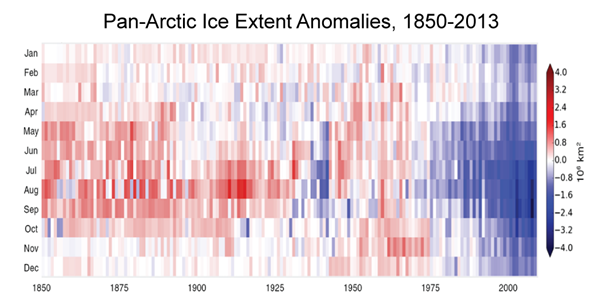Signals From the Arctic: Security Concerns Beyond Historic Experience - Part 1
Photo by: Paul Gierszewski

Credit: NOAA at NSIDC; http://nsidc.org/arcticseaicenews/files/2016/08/Figure6.png
It looks like a piece of modern art. Or maybe a colored bar code perhaps? But what the image above actually represents is much more disconcerting. The increasing amount of dark blue towards its right edge shows how far below average Arctic sea ice has been in recent years. The picture is based on observations from historical sources such as whaling ship reports and historical ice charts from Alaska, the Russian Arctic, Canada, and Denmark. While satellite data of the sea ice only go back to 1979, this chart shows that the current situation is unique in the last 150 years.
Each year in September, media attention to the Arctic often increases, especially when there are expectations of another record set in the yearly decline of Arctic sea ice. This year is not another record low– preliminary analysis point to a tie with the 2007 sea ice minimum as the second lowest ice extent on record – but the observations shown above nevertheless confirm the well-established trend of less and less sea ice in the Arctic. Not only does the sea ice cover a smaller area, it is also thinner with less left of the multi-year ice that has given the Arctic Ocean its characteristics of an unforgiving landscape for human endeavor. Moreover, enough other climate records have already been broken recently to show that the time we are living in is, in fact, different from the past. Globally, this year may become the warmest on record, exceeding last year’s highest global average temperate since the late 1800s. The Greenland ice sheet is also melting at a brisk rate. All these changes are is easy to track online with sites that chronicle the warming of our planet.[1]
Translating such data into political insights have been far more challenging, in spite of immense efforts to communicate what climate change might mean for society and the need for political action. Even among audiences that acknowledge the credibility of climate sciences, it appears that it requires some kind of shock to kick the security discourse into gear—such as the unexpected Arctic sea-ice minimum of 2007. This record changed the public discussion about developments in the Arctic from a low-key discourse involving a small set of actors with long-term engagement in the region to high-pitched rhetoric of Arctic meltdown followed by a race for resources that has garnered interest from around the world. The race for resources has quieted down some as raw material prices have fallen through the floor and planned exploitation activities have been abandoned or put on hold, but the political interest in the region remains high. The number of think tanks that are now engaged in Arctic issues, and the media coverage, indicate just how much interest has increased from its miniscule levels before 2007.
However, it appears that the attention brought on by a security discourse all-too-often applies mainly to near-term military build-up and other issues related to national security such as access to resources and showing a physical presence to assert a claim to territory. The investment from several Arctic countries to map the Arctic Ocean sea floor is a case in point, as is an increasing military presence in the region. While some increase in the capacity to navigate the Arctic Ocean is warranted, given expectations of growing economic activities from shipping, extractive industries, and fishing, it does not address the cause of the changing security landscape in the Arctic: the emission of greenhouse gases.
This is the first of a two part blog series. Click here for part two.